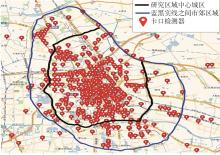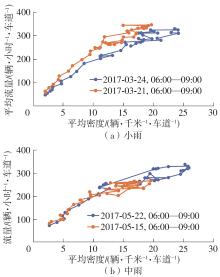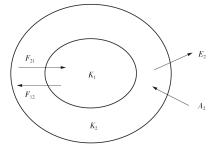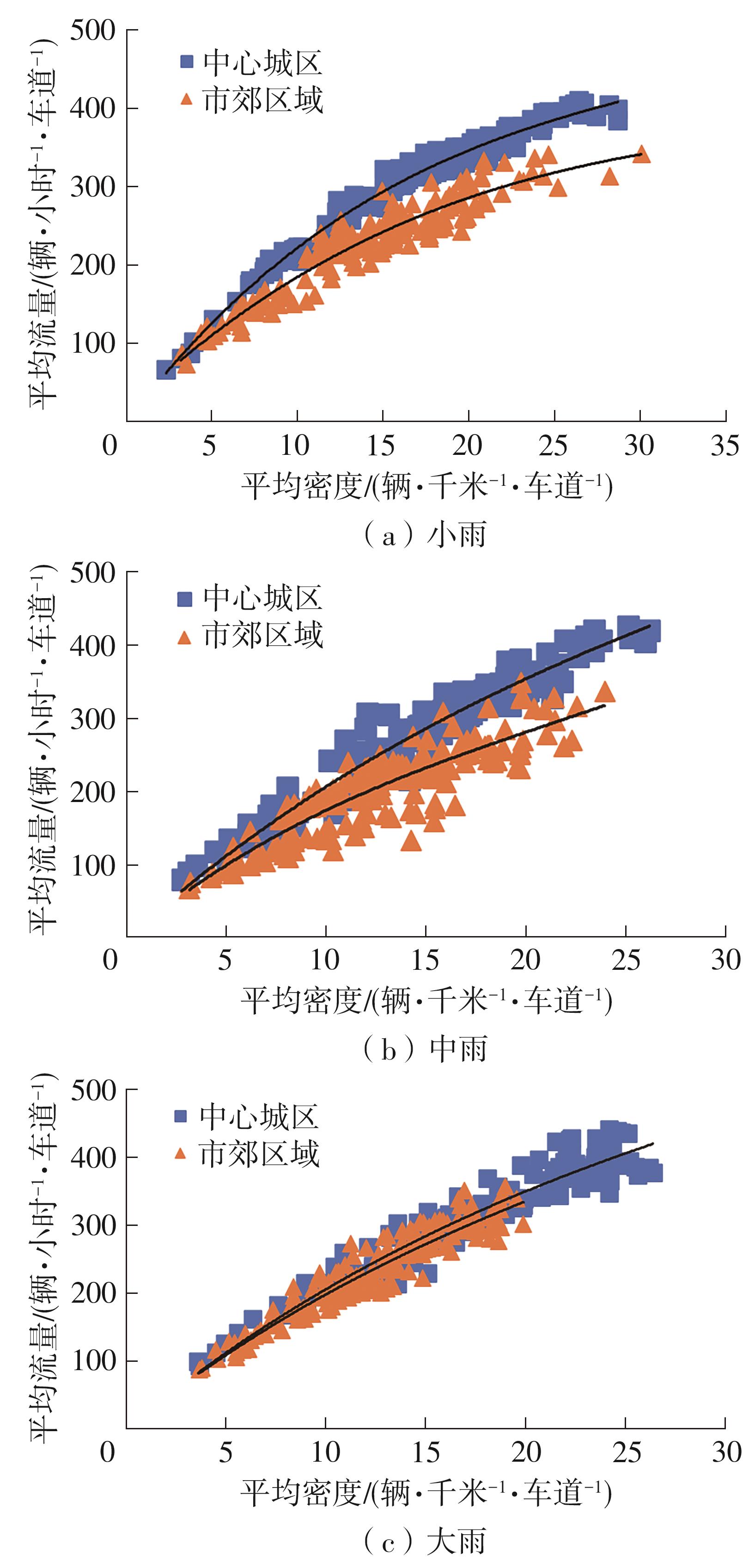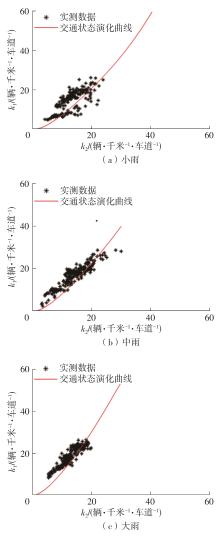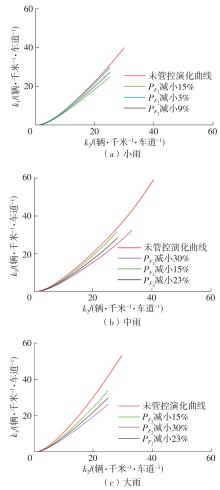Journal of South China University of Technology(Natural Science Edition) ›› 2024, Vol. 52 ›› Issue (1): 72-82.doi: 10.12141/j.issn.1000-565X.220721
• Traffic & Transportation Engineering • Previous Articles Next Articles
Traffic Boundary Control Strategy Based on Macroscopic Fundamental Diagram Under Different Rainfall
ZHAO Xiaomei HAO Guoyu NIU Xiaojing ZHOU Zhiqian
- School of Systems Science,Beijing Jiaotong University,Beijing 100044,China
-
Received:2022-10-30Online:2024-01-25Published:2023-07-14 -
About author:赵小梅(1976-),女,博士,教授,主要从事智能交通系统及宏观基本图研究。E-mail:xmzhao@bjtu.edu.cn -
Supported by:the National Natural Science Foundation of China(71771012)
CLC Number:
Cite this article
ZHAO Xiaomei, HAO Guoyu, NIU Xiaojing, et al.. Traffic Boundary Control Strategy Based on Macroscopic Fundamental Diagram Under Different Rainfall[J]. Journal of South China University of Technology(Natural Science Edition), 2024, 52(1): 72-82.
share this article
Table 2
Rainy levels and different periods of rainfall and no-rain days"
| 降雨 等级 | 日期 | 时段 | 对比无 雨日期 | |||
|---|---|---|---|---|---|---|
| 02:00~08:00 | 08:00~14:00 | 14:00~20:00 | 20:00~02:00 | |||
| 小雨 | 2017-03-23 | 6 | 0 | 0 | 0.1 | 2017-03-09 |
| 2017-03-24 | 3 | 0.5 | 3 | 0.5 | 2017-03-31 | |
| 2017-06-06 | 8 | 0.2 | 0.8 | 0 | 2017-06-27 | |
| 2017-06-23 | 2 | 5 | 0 | 0.7 | 2017-06-16 | |
| 中雨 | 2017-05-22 | 0 | 2 | 10 | 0.6 | 2017-05-15 |
| 2017-06-22 | 0.5 | 6 | 2 | 5 | 2017-06-15 | |
| 2017-07-26 | 0 | 17 | 0.1 | 0 | 2017-07-12 | |
| 2017-08-16 | 0 | 0 | 25 | 0 | 2017-08-30 | |
| 大雨 | 2017-07-06 | 0 | 27 | 13 | 22 | 2017-07-13 |
| 2017-07-21 | 0.6 | 2 | 0 | 49 | 2017-07-07 | |
| 2017-08-09 | 32 | 0.8 | 0 | 0 | 2017-08-30 | |
Table 3
Influence of different rainfall on traffic flow characteristics (06:00—22:00)"
| 降雨等级 | 路网类型 | 平均流量 | 平均速度 | 平均密度 |
|---|---|---|---|---|
| 小雨 | 中心 | 2.84~15.97 | -5.40~4.77 | 9.12~12.95 |
| 市郊 | 0.26~21.79 | -19.51~-5.96 | 17.17~32.84 | |
| 中雨 | 中心 | 1.57~10.34 | -7.55~1.72 | 3.02~20.65 |
| 市郊 | 1.20~11.90 | -13.75~-3.48 | 3.92~27.44 | |
| 大雨 | 中心 | -7.36~1.90 | -3.00~4.90 | -6.87~4.90 |
| 市郊 | -2.66~3.50 | 0.40~4.50 | 4.47~2.61 |
| 1 | 张存保,万平,梅朝辉,等 .雨天环境下高速公路交通流特性及模型研究[J].武汉理工大学学报,2013,5(3):63-67. |
| ZHANG Cunbao, WAN Ping, MEI Chaohui,et al .Traffic flow characteristics and models of freeway under rain weather[J].Journal of Wuhan University of Technology,2013,5(3):63-67. | |
| 2 | 罗京,刘建蓓,郭腾峰,等 .降雨对高速公路交通流特征的影响[J].公路交通科技,2015,32(7):134-139. |
| LUO Jing, LIU Jianbei, GUO Tengfeng,et al .Impact of rainfall in expressway traffic flow characteristics[J].Journal of Highway and Transportation Research and Development,2015,32(7):134-139. | |
| 3 | BILLOT R, FAOUZI N E E, VUYST F D .Multilevel assessment of the impact of rain on drivers behavior[J].Journal of Transportation Research Record,2009(1):134-142. |
| 4 | 杨中良,林瑜,高霄 .恶劣天气条件下城市快速路通行能力研究[J].交通信息与安全,2010,28(1):75-78. |
| YANG Zhongliang, LIN Yu, GAO Xiao .Urban expressway capacity under adverse weather conditions[J].Journal of Transport Information and Safety,2010,28(1):75-78. | |
| 5 | 龚大鹏,宋国华,黎明,等 .降雨对城市道路行程速度的影响[J].交通运输系统工程与信息,2015,15(1):218-225. |
| GONG Dapeng, SONG Guohua, LI Ming,et al .Impact of rainfalls on travel speed on urban roads[J].Journal of Transportation Systems Engineering and Information Technology,2015,15(1):218-225. | |
| 6 | KEYVAN-EKBATANI M, PAPAGEORGIOU M, PAPAMICHAIL I .Urban congestion gating control based on reduced operational network fundamental diagrams[J].Transportation Research Part C:Emerging Technologies,2013,33:74-87. |
| 7 | KEYVAN-EKBATANI M, KOUVELAS A, PAPAMI-CHAIL I,et al .Exploiting the fundamental diagram of urban networks for feedback-based gating[J].Tramsportation Research Part B:Methodological,2012,46(10):1393-1403. |
| 8 | KOUVELAS A, SAEEAMANESH M, GEROLIMINIS N .Enhancing model-based feedback perimeter control with data-driven online adaptive optimization[J].Tramsportation Research Part B:Methodological,2017,96:26-45. |
| 9 | GEROLIMINIS N, HADDAD J, RAMEZANI M. Optimal perimeter for two urban regions with macroscopic fundamental diagram:a model predictive approach[J].IEEE Transactions on Intelligent Transportation Systems,2013,14(1):348-359. |
| 10 | YANG KD, ZHENG N, MENENDEZ M .Optimal perimeter control synthesis for two urban regions with aggregate boundary queue dynamics[J].Transportation Research Part B:Methodological,2017,96:1-25. |
| 11 | YILDIRIMOGLU M, SIRMATEL II, GEROLIMINIS N .Hierarchical control of heterogeneous large-scale urban road networks via path assignment and regional route guidance[J].Transportation Research Part B:Methodological,2019,118:106-123. |
| 12 | ABOUDOLAS K, GEROLIMINIS N .Perimeter and boundary flow control in multi-reservoir heterogeneous[J].Transportation Research Part B:Methodological,2013,56(12):265-281. |
| 13 | KOUVELAS A, SAEEDMANESH M, GEROLIMINIS N .Enhancing model-based feedback perimeter control with data-driven online adaptive optimization[J].Transportation Research Part B:Methodological,2017,96:26-45. |
| 14 | RAMEZANI M, HADDAD J, GEROLIMINIS N .Dynamics of heterogeneity in urban networks:aggregated traffic modeling and hierarchical control[J].Tramsportation Research Part B:Methodological,2015,74:1-19. |
| 15 | HAJIAHMADI M, HADDAD J, DE SCHUTTER B,et al .Optimal hybrid perimeter and switching plans control for urban traffic networks[J].Control Systems Technology,IEEE Transactions on Control System Technology,2015,23(2):464-478. |
| 16 | 廖南楠 .基于MFD的城市路网交通拥堵特性及门限控制方法研究[D].南京:东南大学,2017. |
| 17 | 赵靖,马万经,汪涛,等 .基于宏观基本图的相邻子区协调控制方法[J].交通运输系统工程与信息. 2016,16(1):78-84. |
| ZHAO Jing, MA Wanjing, WANG Tao,et al .Coordinated perimeter flow control for two subareas with macroscopic fundamental diagram[J].Journal of Transportation Systems Engineering and Information Technology,2016,16(1):78-84. | |
| 18 | LI Yishun, XU Jianmin, SHEN Lvou .A perimeter control Strategy for oversaturated network preventing queue spillback[J].Procedia-Social and Behavioral Sciences,2012,43:418-427. |
| 19 | 李轶舜,徐建闽,王琳虹 .过饱和交通网络的多层边界主动控制方法[J].华南理工大学学报(自然科学版) 2012,40(7):27-32. |
| LI Yi-shun, XU Jian-min, WANG Lin-hong .Active multi-layer perimeter control strategy of oversaturated traffic networks[J].Journal of South China University of Technology(Natural Science Edition),2012,40(7):27-32. | |
| 20 | 李长城 .不良天气下的高速公路交通流特性及引导控制研究[D].北京:北京工业大学,2015. |
| [1] | YANG Yazao, WENG Tangzheng. Impact of Spatiotemporal Constraints on Active Travel [J]. Journal of South China University of Technology(Natural Science Edition), 2024, 52(2): 113-123. |
| [2] | ZHUANG Yan, DONG Chunjiao, MI Xueyu, et al.. Identification of Accident Black Spots Based on Improved Network Kernel Density and Negative Binomial Regression [J]. Journal of South China University of Technology(Natural Science Edition), 2024, 52(1): 119-126. |
| [3] | HU Xinghua, CHEN Xinghui, WANG Ran, et al. Optimization Model of Bus Priority Control Considering Carbon Emissions with Stochastic Characteristics [J]. Journal of South China University of Technology(Natural Science Edition), 2023, 51(10): 160-170. |
| [4] | XU Lunhui, YU Jiaxin, PEI Mingyang, et al. Repositioning Strategy for Ride-Hailing Vehicles Based on Geometric Road Network Structure and Reinforcement Learning [J]. Journal of South China University of Technology(Natural Science Edition), 2023, 51(10): 99-109. |
| [5] | SHEN Yutong, LI Ming, CUI Zhiyong, et al. Study on the Multi-Period Allocation Method of Vehicle Resource in Hybrid Service Mode [J]. Journal of South China University of Technology(Natural Science Edition), 2023, 51(10): 89-98. |
| [6] | WANG Hao, XIE Ning . Coordinated Optimization Model of Arterial Segmented Green Waves Considering the Efficiency of Tram Operation [J]. Journal of South China University of Technology(Natural Science Edition), 2023, 51(1): 95-105. |
| [7] | ZHAO Jiandong, ZHU Dan, LIU Jiaxin. Metro Transfer Passenger Flow Prediction Based on STL-GRU [J]. Journal of South China University of Technology(Natural Science Edition), 2022, 50(5): 22-31. |
| [8] | WU Jiaorong XIE Jinhong WANG Yuqin. The Profiling Method of Instability of Bus Route Operation and Its Application [J]. Journal of South China University of Technology(Natural Science Edition), 2022, 50(2): 15-22. |
| [9] | CHEN Xiaohong, HU Fang . Interval Optimization Model of Signal Control at Intersection Based on Possibility Degree [J]. Journal of South China University of Technology(Natural Science Edition), 2022, 50(10): 29-40. |
| [10] | YU Lijun. Generalized System-Optimal Traffic Assignment with Link Capacity Constraints [J]. Journal of South China University of Technology(Natural Science Edition), 2021, 49(4): 140-148. |
| [11] | YAO Enjian LU Muyang LIU Yuhuan YUAN Ling. Electric Bus Area Driving Plan Preparation Considering Charging Constraints [J]. Journal of South China University of Technology(Natural Science Edition), 2019, 47(9): 68-73. |
| [12] | LIU Zhongbo ZHAO Xiaohui. A Dynamic Allocation and Guidance Model for Parking Spaces with Minimum Total Parking Costs#br# [J]. Journal of South China University of Technology(Natural Science Edition), 2018, 46(9): 92-98. |
| [13] | LU Kai LIN Maowei DENG Xingdong XU Guanghui XU Jianmin. A model of area dynamic allocation and guidance of parking space with the minimum total parking cost [J]. Journal of South China University of Technology(Natural Science Edition), 2018, 46(9): 82-91,98. |
| [14] |
CHEN Xiaohong ZHANG Xiekui CHEN Shimiao.
Interval Decision Making Model of Cycle Length at Signal Intersection
|
| [15] | TIAN Sheng XU Kai . Evolutionary Model of Traffic Flow in Crowded and Charged Routes Considering Heterogeneous Travelers [J]. Journal of South China University of Technology (Natural Science Edition), 2018, 46(11): 110-116. |
| Viewed | ||||||
|
Full text |
|
|||||
|
Abstract |
|
|||||
